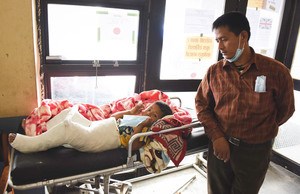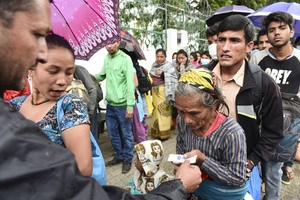SAN FRANCISCO, May 7, 2015 (GLOBE NEWSWIRE) -- In the hours following the 7.8-magnitude earthquake north of Nepal's capital Kathmandu, San Francisco-based Give2Asia began raising money to support local Nepalese organizations working to help the country and its people recover from the natural disaster. Focused on long-term projects that will help the country recover and rebuild, these organizations are being supported by dollars from around the world, including prominent U.S. businesses.
As of today, Give2Asia has set up relief and recovery funds for the Moody's Foundation, Bose, Johnson & Johnson, Advent Software, Seagate Technologies, Tiffany & Co., H.B. Fuller, and EMC Corporation. In addition to making direct grants, some of these corporations have also established employee contribution funds, matching contributions made by their workforces. Their support helped Give2Asia raise over half a million dollars in the days following the disaster, and begin funding relief efforts.
"We have been humbled by the tremendous support and generosity shown by donors in recent days," said Dr. Ta Lin Hsu, Chairman of Give2Asia. "In this moment of great need for the nation of Nepal, to see so many come together to aid and support its people is a powerful statement."
This was the strongest earthquake to hit Nepal in nearly a century, affecting a total of 8 million people in all. In the weeks following the earthquake, the government and local organizations have reported a shortage of food, water, temporary shelter, and first-aid supplies, while hundreds of thousands of people are without homes.
According to Dr. George Varughese, Nepal Country Representative for the Asia Foundation, Give2Asia's primary partner on the ground, the approaching monsoon season could compound recovery efforts, forcing many to leave what is left of their homes to become "internal refugees for six to nine months."
During a joint webinar put on by the Council on Foundations and Center for Disaster Philanthropy, Dr. Varughese spoke about how funding local organizations is the most effective way to support recovery efforts. "We need not only a short-term approach," he explained, "but also a long-term perspective. We have a pretty long list and a database of who is doing good work and where, and because these organizations are based in Nepal, we have to live with the decisions we make about grantmaking."
As part of its commitment to work with the best possible partners in all the countries in which it operates, Give2Asia is working with The Asia Foundation to provide emergency relief and assess the long-term needs in affected areas. Through this collective effort, hundreds of survivors have already received temporary shelter, blankets, and other supplies such as food. According to initial assessments, long-term recovery programs will focus on psychosocial programs, education, livelihood projects, healthcare needs, and supporting marginalized communities, such as the 80 thousand pregnant women affected by the disaster.
"We have experience responding to over 40 disasters in the Asia-Pacific region," said Birger Stamperdahl, President & CEO at Give2Asia. "Each and every time, it is clear to see that supporting local non-government organizations (NGOs) is the most impactful and effective method for assisting disaster-affected communities. The local knowledge and community trust of our partners is key to effective response and long-term recovery."
As part of its commitment to transparency, Give2Asia reports on how every dollar is used to support disaster recovery efforts. To learn more about how you can support local groups in Asia, please visit www.give2asia.org.
About Give2Asia
Give2Asia strengthens communities throughout Asia by building trusted networks for charitable investment. Since its founding in 2001 by The Asia Foundation, Give2Asia has raised over $250 million in gifts and donations from corporate, foundation, and individual donors for community partners in Asia. Give2Asia has demonstrated its effectiveness in serving the needs of international philanthropy with its on-the-ground presence, knowledge of diverse social and economic conditions, and the expert matching of donor interests with innovative and effective grantees.
About Give2Asia Disaster Response
Give2Asia has responded to nearly 40 natural disasters in the Asia Pacific region during the past 10 years with over $40 million in support. Give2Asia's strategy is to support long-term recovery by partnering with local groups based within affected communities. Our programs support rebuilding, economic recovery, psychosocial counseling and other needs that may arise following a disaster. Give2Asia reports back to donors on every dollar spent. Learn more about Give2Asia's disaster response strategy at give2asia.org/disaster.
Available for Interview
Dr. Ta-lin Hsu
Chairman of the Board
Give2Asia
Birger Stamperdahl
President & CEO
Give2Asia
Adam Eads
Director of Disaster Recovery
Give2Asia
Photos accompanying this release are available at:

